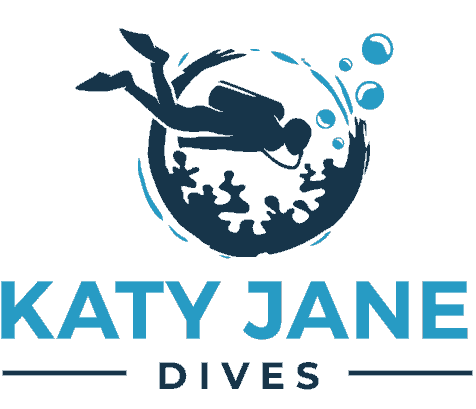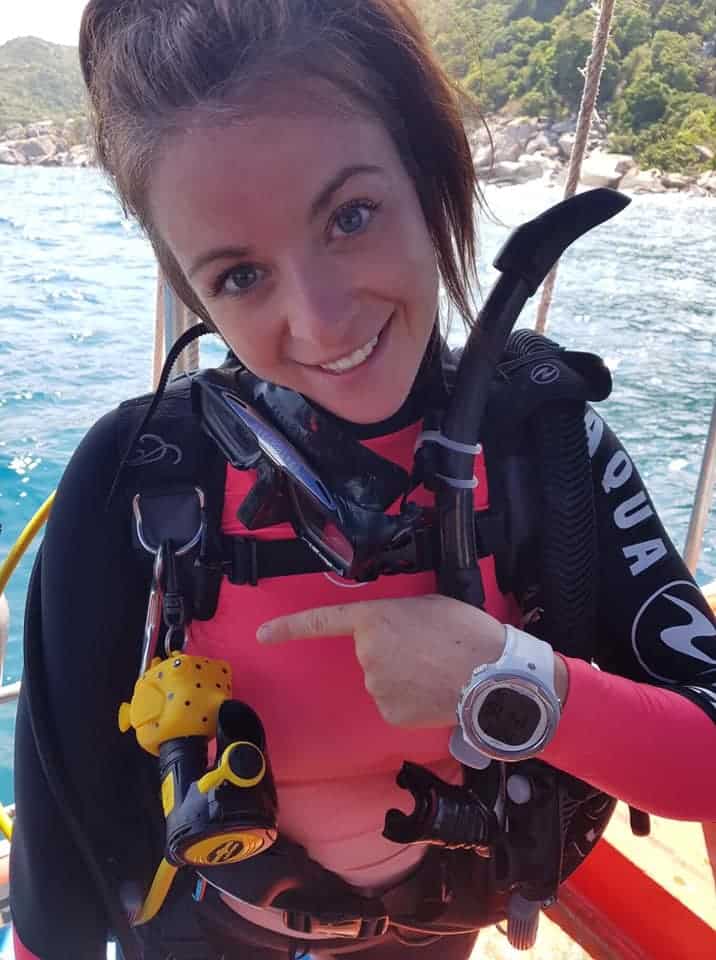Diving with thresher sharks in the Philippines, around Malapascua Island, is one of the most thrilling experiences for any scuba enthusiast. These majestic creatures, with their long, distinctive tails, draw divers from all corners of the globe.
Here’s your comprehensive guide to diving with thresher sharks in the Philippines, now at Kimud Shoal.
Table of Contents
Why Malapascua for Thresher Sharks?
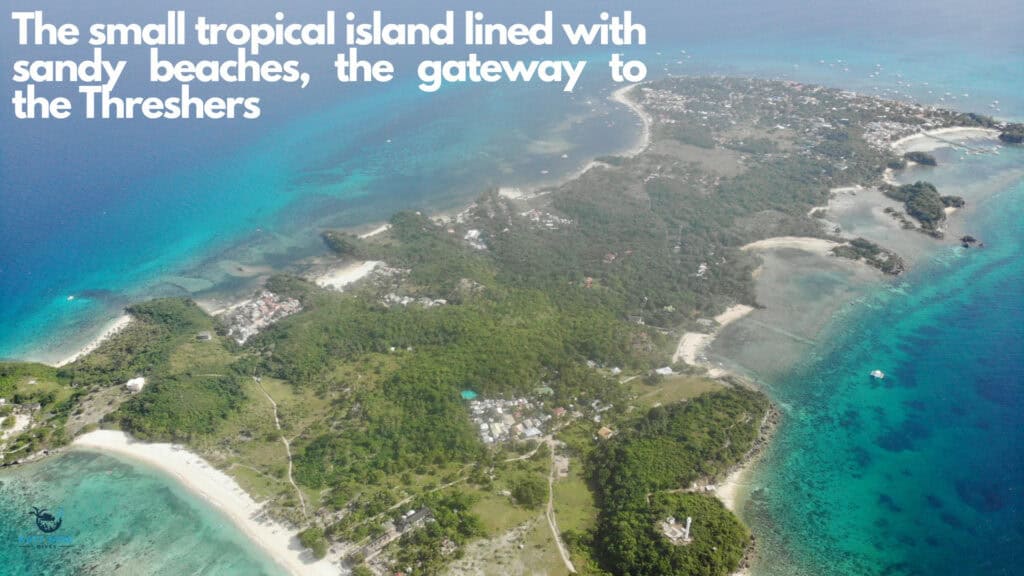
Malapascua Island in the Philippines, just north of Cebu, is one of the few places in the world where divers can almost be guaranteed to see Pelagic thresher sharks (Alopias pelagic).
These elusive creatures typically inhabit deep pelagic waters, rarely coming to the surface, which makes their consistent appearance at Malapascua’s dive sites incredibly unique. They were once commonly seen at Monad Shoal, but sightings there have decreased over the past few years. The exact reason is unknown, but locals have observed that local tiger sharks, which used to patrol deeper waters, are now frequent visitors to Monad. This change in behavior may have driven the thresher sharks to move to the shallower Kimud Shoal.
Divers gather at dawn when the sharks ascend from the depths to visit cleaning stations where cleaner wrasse fish remove parasites from their bodies. This natural, predictable behaviour provides an exceptional opportunity to observe these sharks in their natural environment without any baiting or feeding involved.
Typically, divers can expect to encounter between 4 to 7 thresher sharks per dive at these sites, making it one of the most reliable locations globally for observing these magnificent animals.
Malapascua’s significance is heightened by the fact that thresher sharks are an endangered species, with their numbers declining due to overfishing and habitat loss. Seeing them here is not only a thrilling experience but also a stark reminder of the importance of marine conservation. Witnessing these ancient, graceful predators—creatures that have survived five mass extinctions—is a humbling experience, underscoring our responsibility to protect such vulnerable marine life and their habitats.
Diving in Malapascua should be an opportunity to participate in a form of ecotourism that supports local conservation efforts and contributes to the protection of these incredible creatures and their environment.
Preparing for Your Dive
Getting ready for a dive with thresher sharks in Malapascua requires careful preparation to ensure both safety and the best possible experience.
- Recommended Scuba Certification: Ensure you have at least an Advanced Open Water certification. This is important as the dives can reach over 18 meters, and the conditions can be challenging with some strong currents. Excellent buoyancy control and comfort in currents are essential.
- Get a Good Night’s Sleep: Dives to see the thresher sharks are in the early-morning, with departures from Malapascua Island typically between 4:00 and 4:30 AM. A restful night’s sleep will help you be alert and ready for the dive.
- Don’t Forget Your Cameras: Capturing these majestic creatures is a unique highlight for many divers, so make sure your camera is ready and charged.
- No Artificial Lighting: Keep your dive lights and camera strobes turned off. The thresher sharks have extremely large, light-sensitive eyes that can be easily damaged by bright lights. Embrace the natural morning light for your photos.
- Equipment Check: Double-check all your diving gear before heading out. Make sure your regulator, BCD, and other essential equipment are in perfect working order.
- Hydration and Nutrition: Drink plenty of water the night before and have a light, healthy breakfast to maintain energy levels for the early morning dive.
- Listen to Your Guide: Follow all instructions from your dive guide closely. They have the experience and knowledge to ensure a safe and successful dive.
The Dive Experience
Malapascua offers world-class shark diving, an experience that cannot be replicated anywhere else in the world.
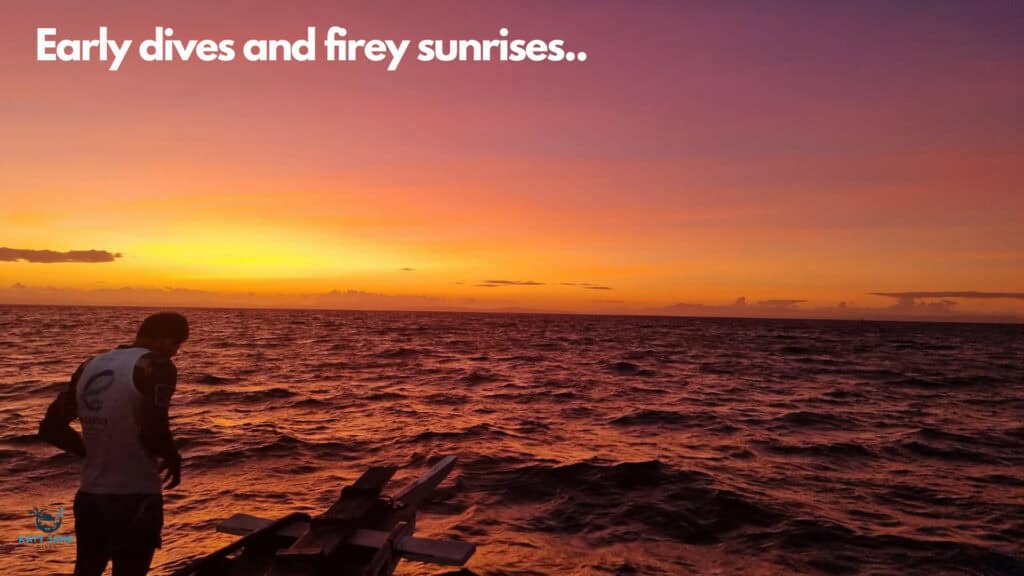
Dive Briefing
A detailed dive briefing is crucial for a safe and enjoyable experience at Kimud Shoal. The guide will outline the dive plan, highlighting the depth ranges and potential currents you might encounter. They will emphasise the importance of maintaining excellent buoyancy and following the dive leader closely .
Safety procedures are a key part of the briefing. You’ll be reminded to keep your distance from the thresher sharks and avoid any sudden movements to prevent startling them. The guide will also stress the importance of not using artificial lights or camera strobes, as the sharks have extremely light-sensitive eyes that can be easily damaged by bright lights.
Finally, the briefing will cover what to expect underwater. This includes information on the cleaning stations where the sharks are typically found, the other marine life you might encounter, and how to safely navigate the dive site while respecting the delicate reef ecosystem.
Getting to Kimud Shoal
Divers encounter thresher sharks at dawn so the journey to Kimud Shoal begins before sunrise, setting the stage for quite an incredible dive.
The boats schedule typically depart from Malapascua Island between 4:00 and 4:30 AM, ensuring you arrive at the dive site just as the day breaks. The boat ride to Kimud Shoal takes approximately 50 minutes, offering plenty of time to prepare.
During the ride, you can enjoy a hot drink and set up your dive gear. The early morning journey also provides a perfect opportunity to relax and take in the breathtaking sunrise over the water, a serene prelude to the exciting dive ahead. Ensuring all equipment is ready and discussing the dive plan with your fellow divers will help make the most of this unique experience.
The Dive
Once there, you’ll gear up and enter the water, descending to around 12-18 meters and waiting near the cleaning stations.
It won’t be long before you spot your first shark. The sight of a thresher shark gracefully appearing from the blue and gliding through the water with its scythe-like tail is an awe-inspiring moment for any diver.
Heading towards the cleaning stations, you will witness the sharks circling slowly, often following a figure of eight movement, allowing cleaner wrasse to remove parasites from their skin and gills. As a diver, witnessing these interections really emphasises the essential roles of the cleaning stations, which are themselves dependent on a healthy reef.
This site offers a significant advantage for recreational divers over Monad Shoal with its shallower depths. This allows divers to have longer bottom times and worry less about non-decompression limits (NDLs). The shallower site also means clearer visibility and more light, enhancing the overall diving experience.
What Marine Life Can Be Seen Besides Thresher Sharks?
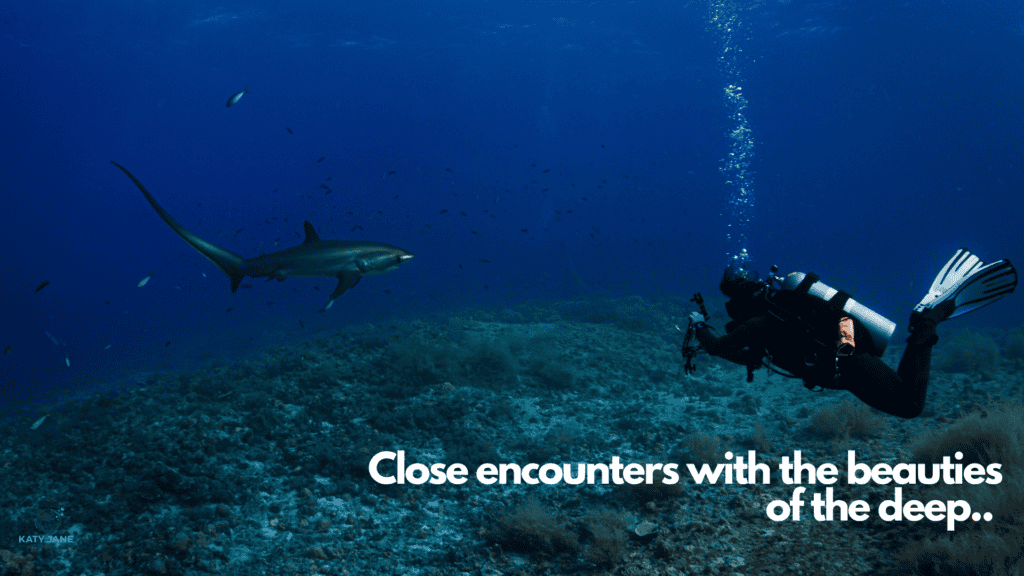
While diving with thresher sharks in the Philippines is the main attraction, Kimud Shoal also offers encounters with other marine life.
Divers could spot:
- Manta rays
- Devil rays
- Whitetip reef sharks
- Hammerhead sharks
- Barracudas
- Tuna
- Snappers
- Trevallies
- Moray eels
- Various nudibranchs
- Colorful reef fish
- Soft and hard corals
However, there are already clear signs of the pressures that this dive site is facing – pressures from warming oceans, destructive fishing practices and bad diving etiquette. As time passes and these trends continue, the diversity of species at Kimud will inevitably decrease. More on this shortly..
How Do I Get to Malapascua Island?
To get to Malapascua Island, you’ll first need to fly into Mactan-Cebu International Airport in Cebu City.
From Cebu, make your way to the North Bus Terminal, where you can catch a Ceres bus heading to Maya Port. The bus journey takes about 4 to 5 hours. Alternatively, you can hire a private car or van for a faster, more comfortable ride, which takes around 3.5 to 4 hours.
Once you arrive at Maya Port, you can take a public ferry or hire a private boat for the 30 to 45-minute ride to Malapascua Island. Ferries typically run from early morning until late afternoon, so plan to reach Maya Port before 4:00 PM. Upon arrival at Malapascua, the ferry will drop you off at one of the main beaches, from where you can easily reach your accommodation.
Best Time to Visit
The best time to see thresher sharks in the Philippines is during the dry season, from November to May.
Peak visibility and calm seas make the months from March to May ideal for these dives. However, thresher sharks can be seen year-round, ensuring Malapascua remains a reliable spot for these encounters.
There are many incredible places to dive across this archipelago.
Read my best diving in Philippines article to find out some of the other top spots to visit!
Dive Operators and Accommodation
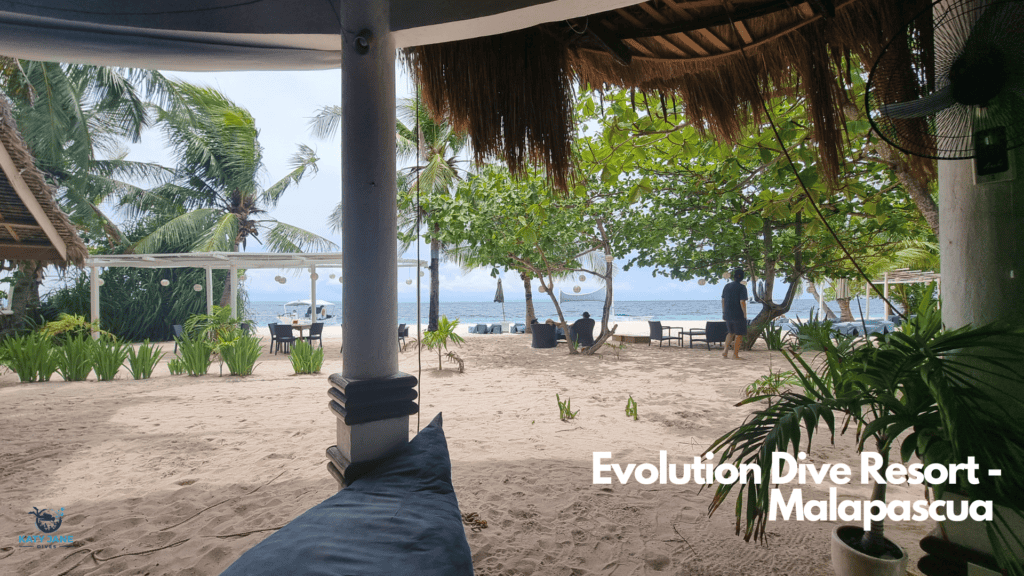
Several dive operators in Malapascua specialise in thresher shark dives.
However, having unfortunately seen first hand the behaviour of divers from a range of dive centres, it is really important to choose a reputable one like Evolution Diving.
Evolution is a small, owner-operated resort offering everything needed for a memorable diving holiday. Equipment can be provided by the dive centre and the resort features 16 rooms with a choice of air conditioning or fan, all within a short distance of a golden white sand beach.
Home to one of the highest-rated restaurants in the province, The Craic House, the resort offers delicious homemade food for all palates, including a great selection of vegetarian dishes.
This centre offers experienced guides, whose dive briefings provide a comprehensive overview of best practice expected from divers – excellent buoyancy, no touching or standing on the reef, no chasing sharks. Obvious things, you may think. But from what we saw from divers with other centres, not obvious enough.
They are fully set up for technical divers too, offering an impressive selection of kit for those divers that enjoy longer and deeper dives.
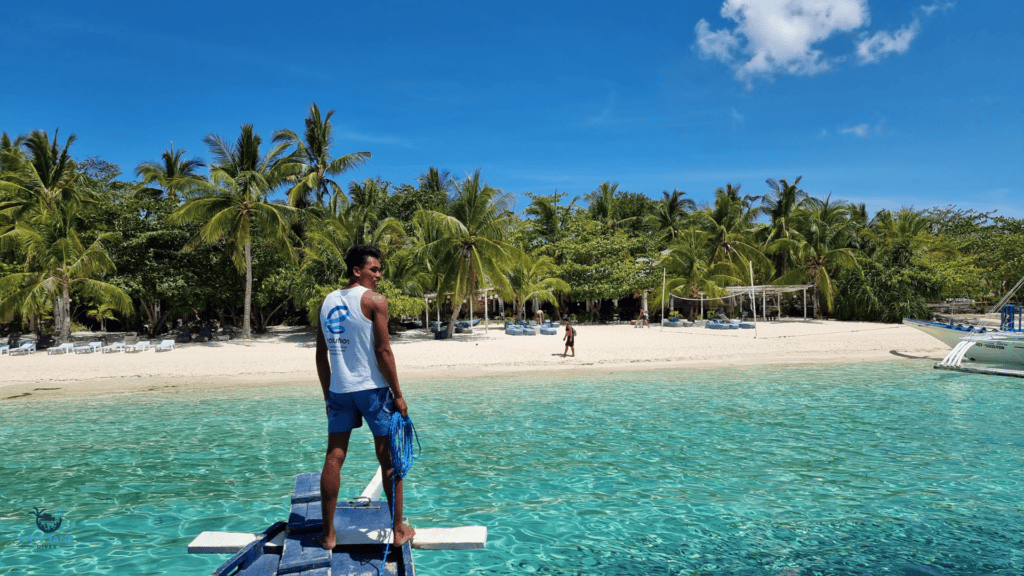
I stayed here for 6 nights and did two dives each day. They also have afternoon dives, and offer night dives too.
I spent some time walking down the beachfront and checking out the other resorts and I can confidently say, that whilst it may not be the cheapest, it is the most attractive resort for divers looking for a environmentally friendly and safe diving experience.
Are Thresher Sharks Protected?
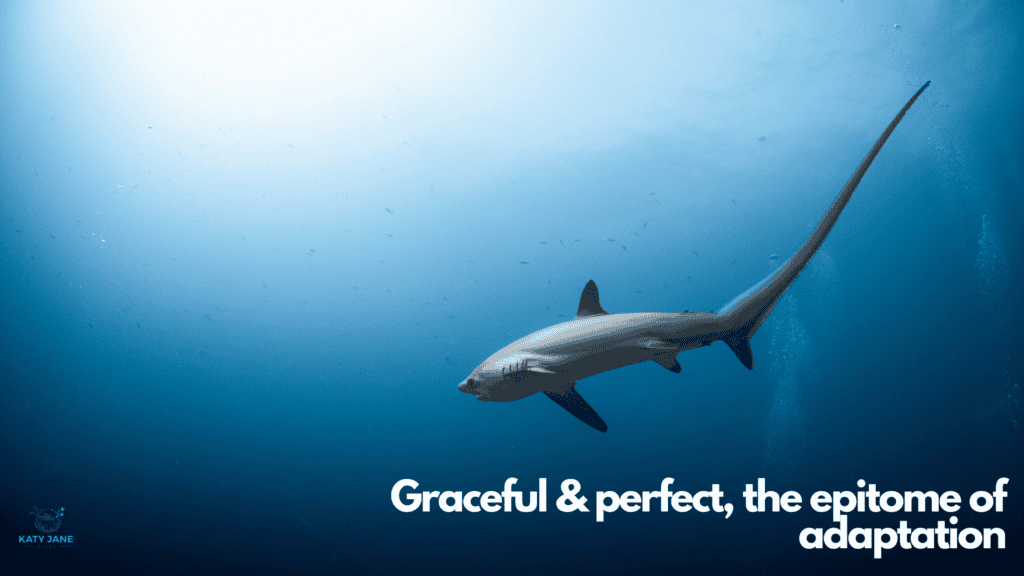
Thresher sharks are listed as vulnerable by the International Union for Conservation of Nature (IUCN). This classification indicates that thresher sharks face a high risk of extinction in the wild due to overfishing and bycatch. In response to their declining numbers, several measures have been implemented to protect these magnificent creatures.
In the Philippines, thresher sharks are protected under various national and local regulations. The Philippine government has established marine protected areas (MPAs) where fishing and other activities harmful to marine life are restricted or prohibited. Malapascua Island, a prime location for thresher shark sightings, benefits from these protections.
I visited Malapascua on a group expedition led by UK shark and marine conservation charity Shark Guardian.
We had a week full of diving, socialising and learning about Thresher sharks and how our contributions to citizen science projects such as eOceans can help lead to their protection. This is the best way to dive!
Shark Guardian run expeditions globally, with another one to Malapascua scheduled next year – so keep a close eye on their expeditions page for more information!
Moreover, international agreements such as the Convention on International Trade in Endangered Species of Wild Fauna and Flora (CITES) regulate the trade of thresher sharks. Thresher sharks are listed under CITES Appendix II, which means that their trade is monitored and controlled to prevent over-exploitation.
Conservation organisations and local communities also play a crucial role in protecting thresher sharks. Initiatives such as community-based monitoring, education programs, and sustainable tourism practices help raise awareness and promote conservation.
Educating dive guides so they can pass this knowledge to their guests is vital. It’s encouraging to see organisations like Shark Guardian supporting this effort by providing informative guides to dive centres for use in their briefings. Knowledge is power, and spreading awareness is key to ensuring the health and sustainability of Kimud Shoal and its marine life.
For more detailed information on thresher shark conservation, you can refer to sources like the IUCN Red List, CITES, and local Philippine environmental agencies.
Shark eco-tourism is a major part of many economies around the world.
On an annual basis, shark ecotourism brings in $314 million worldwide and this number is expected to increase over the next 20 years to $700 million – read more about how shark eco-tourism plays a role in ocean conservation.
Final Thoughts
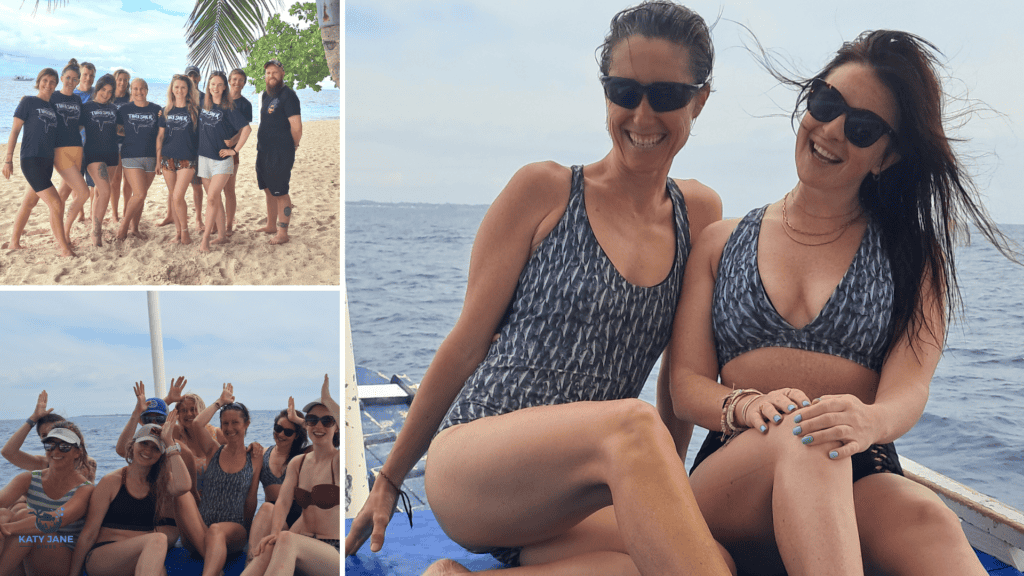
Diving with thresher sharks in the Philippines, in Malapascua at Kimud Shoal, is a unique and unforgettable experience.
The early morning dives, the thrill of seeing these magnificent sharks, and the vibrant marine life make it a top destination for divers.
Prepare well, dive safely, make your dive count by contributing to citizen science projects, and enjoy one of the most remarkable underwater adventures the Philippines has to offer.
